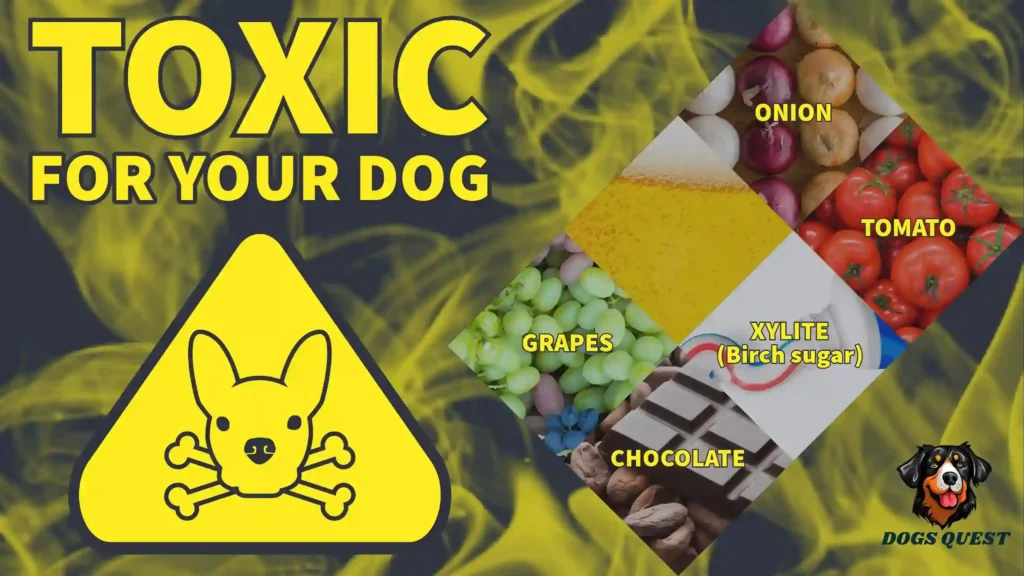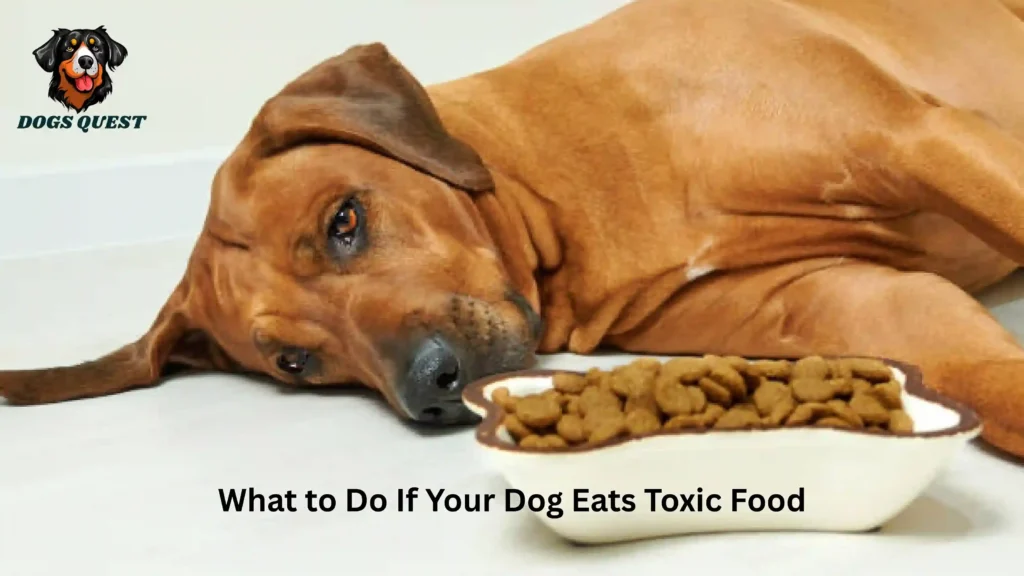Discover what foods are toxic to dogs and protect your furry friend from hidden dangers. Learn about 15 common foods that can harm your dog and what to do if they eat them.Wondering what foods are toxic to dogs? Learn about 15 dangerous human foods that can harm your pup, the symptoms to watch for, and safe alternatives for a healthier diet.
Introduction
If you’ve ever caught your pup staring at your plate with those irresistible puppy-dog eyes, you know how tempting it is to slip them a bite. But here’s the problem: not everything we humans enjoy is safe for dogs. In fact, many everyday foods can cause serious health problems—or even be fatal.
That’s why it’s so important to know what foods are toxic to dogs. In this guide, we’ll go through the most common foods that can harm your pup, why they’re dangerous, and what you should do if your dog accidentally eats one.
Why Knowing What Foods Are Toxic to Dogs Matters

Dogs have very different digestive systems than humans. Foods that are perfectly safe for us can wreak havoc on their bodies. Some ingredients damage their organs, others mess with their blood sugar, and a few are outright poisonous.
Even small amounts of certain foods can trigger problems like vomiting, diarrhea, seizures, and in extreme cases, death. By understanding what foods are toxic to dogs, you can avoid accidents, prevent unnecessary vet visits, and keep your furry companion healthy and happy.
Common Foods That Are Toxic to Dogs
Below is a breakdown of 15 common foods you should keep away from your dog. If you’ve ever wondered what foods are toxic to dogs, this list covers the most dangerous ones.
Chocolate
Chocolate tops nearly every list of what foods are toxic to dogs. It contains theobromine and caffeine, both of which overstimulate a dog’s nervous system and heart. Dark chocolate and baking chocolate are the most dangerous.
Symptoms in dogs: Restlessness, vomiting, diarrhea, rapid breathing, seizures, or even death in large amounts.
Grapes and Raisins
These tiny fruits may seem harmless, but they can cause sudden kidney failure in dogs. The exact substance that makes grapes toxic remains unknown, but even one grape can be harmful.
Symptoms: Vomiting, lethargy, dehydration, decreased urine production.
Onions and Garlic
Onions, garlic, chives, and leeks all belong to the allium family, which is extremely harmful to dogs. These foods damage red blood cells and can cause anemia.
Symptoms: Weakness, pale gums, fainting, elevated heart rate.
Avocados
Avocados contain persin, a toxin that can upset a dog’s stomach and in large amounts cause heart damage. The pit is also a choking hazard.
Symptoms: Vomiting, diarrhea, breathing difficulties if consumed in excess.
Alcohol
Even a small amount of alcohol can be deadly to a dog. It depresses the nervous system and can lead to coma or death. That includes beer, wine, spirits, and even foods cooked with alcohol.
Symptoms: Lack of coordination, vomiting, seizures, slowed breathing.
Macadamia Nu
Macadamia nuts are among the most dangerous nuts for dogs. Just a few can make your pet extremely sick.
Symptoms: Weakness, tremors, vomiting, high body temperature.
Xylitol (Artificial Sweetener)
Xylitol is a sugar substitute found in sugar-free gum, candy, baked goods, and even some peanut butters. It’s one of the deadliest items on the list of what foods are toxic to dogs because it can cause a rapid insulin release.
Symptoms: Sudden drop in blood sugar, seizures, liver failure.
Caffeine
Dogs are far more sensitive to caffeine than humans. Coffee, tea, energy drinks, and even caffeine pills can all be dangerous.
Symptoms: Restlessness, excessive panting, increased heart rate, muscle tremors.
Raw Dough (Yeast Dough)
If a dog eats raw dough with yeast, it continues to expand in the stomach, causing bloating and severe discomfort. The fermentation also produces alcohol, adding to the danger.
Symptoms: Stomach swelling, vomiting, weakness, alcohol poisoning.
Cooked Bones
Many people think giving their dog bones is natural, but cooked bones splinter easily. These splinters can cause choking, blockages, or punctures in the digestive tract.
Symptoms: Gagging, constipation, bloody stool, abdominal pain.
Raw or Undercooked Meat, Fish, and Eggs
Raw foods can contain bacteria like Salmonella and E. coli, which make dogs sick. Certain fish like salmon may also carry parasites.
Symptoms: Vomiting, diarrhea, fever, loss of appetite.
Dairy Product
While some dogs tolerate small amounts of cheese or yogurt, many are lactose intolerant. Consuming dairy can upset their stomach.
Symptoms: Gas, bloating, diarrhea, abdominal cramps.
Salt and Salty Snacks
Too much salt can lead to sodium ion poisoning in dogs. Avoid giving them chips, pretzels, or heavily salted meats.
Symptoms: Vomiting, tremors, seizures, excessive thirst, kidney damage.
Mushrooms (Certain Varieties)
Not all mushrooms are toxic, but some wild mushrooms are deadly. Dogs are more likely to eat mushrooms outdoors, so be cautious on walks.
Symptoms: Vomiting, seizures, liver failure, death in severe cases.
Apple Seeds, Cherry Pits, and Stone Fruit Seeds
The seeds and pits of apples, cherries, peaches, and plums contain cyanide compounds. While the fruit flesh is safe, the pits are dangerous.
Symptoms: Difficulty breathing, dilated pupils, shock.
What to Do If Your Dog Eats Toxic Food

Even if you’re careful, accidents happen. If your dog eats any of the foods listed above, here’s what to do:
- Stay calm – panic won’t help your dog.
- Check what they ate – how much and when.
- Call your vet immediately – describe the food and quantity.
- Contact an emergency pet poison hotline if your vet isn’t available.
- Never induce vomiting without professional advice – some substances can cause more harm coming back up.
Knowing what foods are toxic to dogs is only half the battle—you also need to act quickly when something goes wrong.
Safe Alternatives for Treats
If your dog loves human food, don’t worry—you don’t have to deprive them completely. Many healthy foods are safe in moderation:
- Carrots
- Blueberries
- Apples (without seeds)
- Plain cooked chicken or turkey
- Pumpkin
- Peanut butter (xylitol-free)
These options make excellent training rewards or snacks without putting your pup at risk.
Conclusion
Being a pet parent comes with responsibilities, and one of the biggest is keeping your dog safe from harmful foods. By understanding what foods are toxic to dogs, you can protect your furry friend from unnecessary pain, sickness, and emergencies.
Remember: just because something is safe for you doesn’t mean it’s safe for your pup. Share this knowledge with friends, family, and fellow dog lovers—because knowing what foods are toxic to dogs could literally save a life.
FAQs About What Foods Are Toxic to Dogs
Q1. What foods are toxic to dogs the most?
The most toxic foods for dogs include chocolate, grapes, raisins, onions, garlic, macadamia nuts, and anything with xylitol. These can cause severe health issues, including organ failure or death.
Q2. Can a small amount of toxic food harm my dog?
Yes. Even a small amount of chocolate, grapes, or xylitol can be life-threatening. When wondering what foods are toxic to dogs, remember that size, breed, and sensitivity all play a role—but it’s best to avoid risky foods altogether.
Q3. Is it safe to give my dog human food at all?
Yes, but only certain foods. Safe options include plain cooked chicken, carrots, blueberries, and pumpkin. Knowing what foods are toxic to dogs will help you choose healthy alternatives without putting your pup at risk.
Q4. What should I do if my dog eats something toxic?
Call your vet immediately. Provide details about what your dog ate, how much, and when. Never induce vomiting unless a vet instructs you. Quick action is critical once you know what foods are toxic to dogs and your pet accidentally consumes one.
Q5. Are all fruits dangerous for dogs?
No, not all fruits are harmful. Apples (without seeds), bananas, and watermelon are safe. However, grapes, cherries, and stone fruit pits are dangerous. When learning what foods are toxic to dogs, fruits with seeds or pits should always raise caution.

